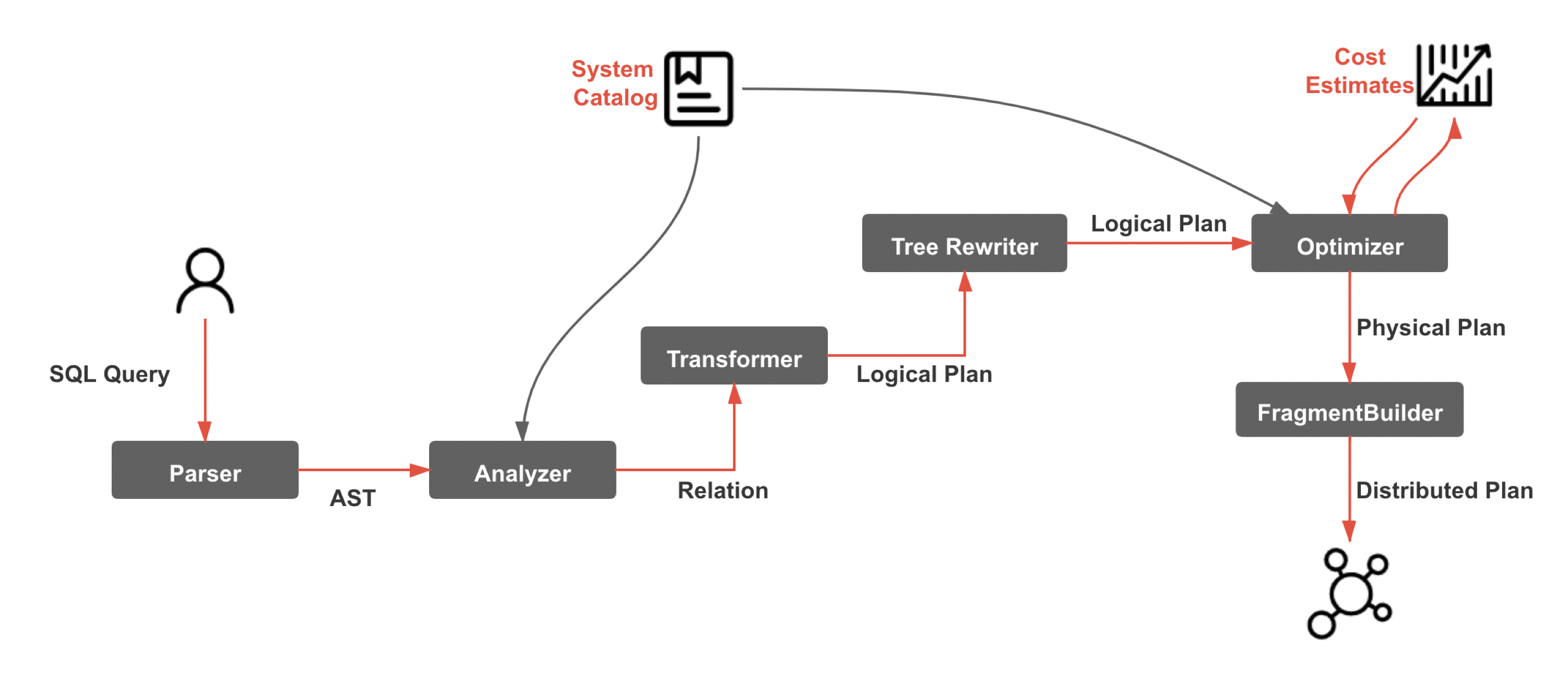
Query Plan
Query Plan

Join StarRocks Community on Slack
Connect on SlackTABLE OF CONTENTS
Publish date: Dec 28, 2023 6:22:47 PM
What Is a Query Plan?
A query plan, also known as a query execution plan, is a detailed roadmap devised by a database management system to execute a SQL query efficiently. It outlines the steps and methods the system will employ to retrieve and process data. The plan is pivotal in ensuring effective database performance, as it influences how quickly and efficiently data can be retrieved.
Generating a Good Query Execution Plan
How Does a Query Work?
Understanding how a SQL query is processed and transformed into results involves a multi-layered approach applicable to most database systems. Here's a high-level overview:
-
Network Layer Interaction: The SQL query begins its journey at the network layer, which acts as the gateway for incoming queries.
-
Planner's Role: Once received, the planner interprets the SQL query, crafting a physical distributed plan tailored to the specific requirements of the case.
-
Execution Engine's Function: This plan is then forwarded to the execution engine, which is responsible for scanning and retrieving data from the storage engine.
-
Predicate Pushdown and Data Scanning: Ideally, predicate pushdown is employed, allowing for selective data scanning, rather than processing the entire dataset.
-
Result Computation and Delivery: The execution engine computes the result based on the physical plan and returns it to the user.

Each layer plays a crucial role in ensuring scalability, stability, and overall performance, with sub-components within each layer contributing to the process.
How to Generate a Good Query Execution Plan?
To understand how to craft an effective query execution plan, particularly in the context of StarRocks and its approach, we consider the following steps:
-
Parsing to Abstract Syntax Tree (AST): The SQL query is first parsed, converting it into an AST. This step involves understanding the query's structure and its legal aspects, including handling aliases.
-
Logical Plan Formation: The AST then undergoes transformation into a logical plan. This stage involves optimizing the query through various techniques like expression reuse and predicate pushdown.
-
Physical Plan Generation by the Optimizer: The optimizer takes over next, converting the logical plan into a physical plan. This phase is critical as it determines the actual execution strategy of the query.
-
Distributed Plan Creation: The process concludes with the creation of a distributed plan by the fragment builder, which guides the execution process.

The critical distinction here lies between the logical and physical plans. The logical plan outlines what the query aims to achieve, whereas the physical plan focuses on how these goals are accomplished. The physical planning stage is where significant optimization opportunities exist, emphasizing the optimizer's role as a key element in the entire process.
Optimized vs. Unoptimized Plans
The distinction between optimized and unoptimized query plans primarily lies in how efficiently they use resources and execute the query. Optimized plans ensure minimal resource consumption and faster query execution, while unoptimized plans often lead to inefficient resource usage and slower performance.
Key Factors in Query Plan Optimization
-
Indexes: Essential for efficient data retrieval, influencing the optimizer's choice of plan.
-
Data Distribution: Affects the optimizer's decision; uneven distribution can lead to less optimal plans.
-
Query Complexity: More complex queries present multiple execution possibilities that the optimizer must evaluate.
-
Database Design: A well-designed database schema enhances the efficiency of query execution plans.
Techniques for SQL Query Optimization
-
Indexing Strategy: Focusing on columns used in
WHERE,JOIN,ORDER BYclauses. -
Query Structure and Rewriting: Simplifying complex queries and using appropriate join types.
-
Table Partitioning: Dividing large tables into smaller parts for more efficient data access.
-
Column Selection: Avoiding
SELECT *in favor of specifying necessary columns. -
Statistics Maintenance: Keeping database statistics current for efficient plan generation.
-
Query Caching: Reducing load on the database by storing frequently accessed query results.
-
Normalization/Denormalization: Balancing these aspects can sometimes enhance performance.
-
Database Configuration: Adjusting settings like memory allocation and parallelism based on workload and hardware resources.
StarRocks and Its Approach to Query Planning
At the heart of StarRocks' query planning is the CBO's ability to navigate a complex and expansive search space. Unlike rule-based systems that rely on a fixed set of heuristics, the CBO in StarRocks evaluates the potential paths a query could take, especially in multifaceted operations like join reordering. This process involves a thorough analysis of various execution plans, where the optimizer considers an array of factors, including the statistical distribution of data, to determine the most efficient execution path. The depth and breadth of this analysis enable StarRocks to optimize queries in a way that significantly reduces execution times, often from minutes to seconds.
Furthermore, StarRocks' CBO is intricately designed to be deeply integrated with the database's execution and storage layers. This close integration means that the optimizer is not just a standalone component but a core part of the database system that interacts seamlessly with other components. Such integration is critical in ensuring that the optimizer can effectively utilize the available data and system resources to generate the most efficient query plans.
In addition to its cost-based optimization, StarRocks employs advanced data pruning techniques, like the global runtime filter, to further enhance query performance. This method effectively reduces the data processed during query execution, thereby minimizing the CPU's workload. Implementing these techniques in a distributed environment, where network overhead can be a concern, showcases StarRocks' capability to balance efficiency with practical constraints.
Conclusion
Effective query plan generation and optimization are crucial for high-performance database systems. These strategies, coupled with continuous monitoring and refinement of execution plans, can significantly improve database efficiency and responsiveness. Understanding and implementing these concepts is key to maintaining an optimized database environment.


.jpg)
-1.webp)